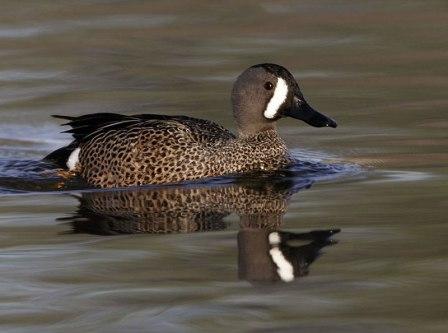
Friends or Enemies?
Picture below taken by Jerry Kirkhart.

The blue winged teal has a great importance
to humans. Along with the popular
white tailed deer, they are popular with hunters as they are a beautiful
catch with their coloration of blue on the wings and in the
males, the crescent on the head. Hunting is a sport that is seen
by many to control the populations of such species. In the case
of the blue winged teal, hunting regulations are altered in
order to accommodate for a lack or surplus of this species. In
terms of hunting, human error had evolved with lead and copper
as means of shots. There was evidence that waterfowl species
would consume the stray lead or copper pellet shots in order to
aid in the digestion of their food. However, once ingested, the
lead and copper would be absorbed and the duck would become
poisoned. There was a nationwide ban on the use of lead shot for
waterfowl hunting and a switch to steel shot was made. This ban
was of great success in saving the populations of waterfowl.
Another way humans are involved with the species of the blue winged teal is the habitat it lives in. Pesticides being used by humans are affecting the diet of this duck and causing death or great harm. Trash, such as plastic bags, has become a source of danger for waterfowl due to it becoming trapped inside of or by its consumption of the trash. The destruction of the wetlands that humans are performing is causing a decline in the numbers of blue winged teal since they are not able to find suitable nesting grounds. Drainage for agriculture have caused a loss in wetlands, not allowing them to form a nest in many places they used to.
As in the case of many other birds, blue winged teals can negatively affect humans in the area of carrying the avian influenza.
Blue winged teals, as mentioned in the nutrition section, are known to eat mostly aquatic vegetation, seeds, and aquatic invertebrates. Therefore, they do not play an important role in the predation of other species. However, there is a high predation for the blue winged teal by certain animals such as raccoons, coyote, skunks, foxes, badgers, ground squirrels, and fox snakes. The blue winged teal has been known to flock with other species of waterfowl, including the Wood duck and the Common Merganser where they reside in similar habitats except for during the breeding season.
This teal has been known to be infected with disease and parasites such as Clostridium botulinum, Cestoda, aspergillosis, and the duck plague.
